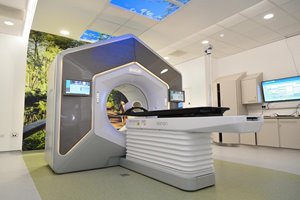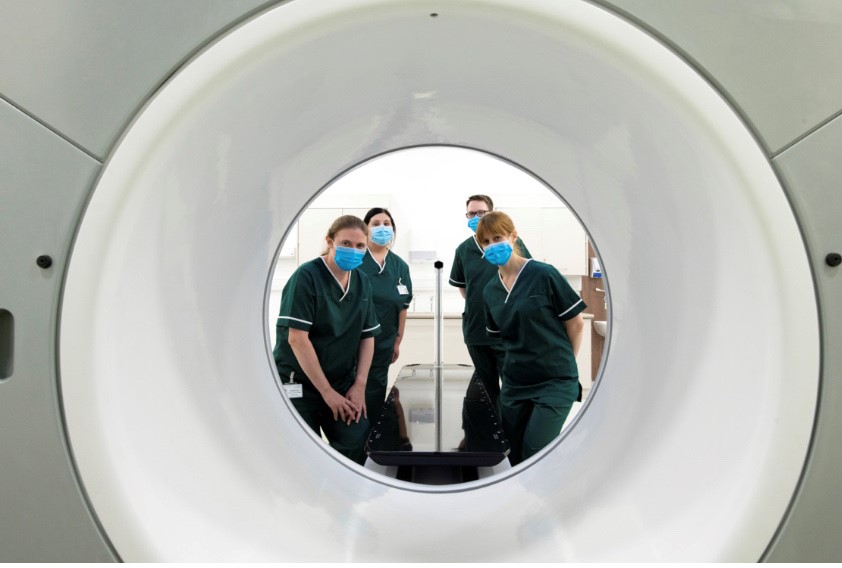St Luke’s Cancer Centre in Guildford provides radiotherapy services at both the Royal Surrey County Hospital and at the East Surrey Hospital, covering a population of more than 1.2 million. The centre sees 3,000 referrals each year, with an average 200 – 250 patients undergoing radiotherapy at any one time.
External beam, image-guided, intensity-modulated, stereotactic radiotherapy and brachytherapy are among some of the services offered. The site houses five linear accelerators (linacs) comprising Varian Clinac and TrueBeam machines. With the last Clinac reaching the end of its lifetime in April 2020, the decision was faced as to whether to replace it with a TrueBeam, matching the existing cohort, or the state-of-the-art Varian Halcyon.
A multi-disciplinary radiotherapy team was involved from the outset, eventually deciding that the Halcyon’s improved workflow efficiencies and enhanced patient experience outweighed the logistical difficulties of a stand-alone unit and the business case progressed on that basis.
Just before the business case was submitted, the Ethos Therapy System was launched by Varian and members of the team saw its exciting new features demonstrated at a European conference.
The Ethos software enables the Halcyon to perform adaptive radiotherapy (ART) using artificial intelligence (AI). The AI software utilises Cone Beam Computerised Tomography (CBCT) to adapt the original treatment plan to account for daily variability in a tumour's shape and position due to changes in nearby organs. This results in greater accuracy of treatment to the Primary Target Volume (PTV) while decreasing dose to the surrounding organs at risk.
As this would be the last machine replacement at St Luke’s for four years, the opportunity to invest in cutting-edge technology could not be missed. The business case was amended to include Ethos software, and was accepted by the Trust.
Building work began with only a slight delay due to the Covid-19 pandemic. The new machine arrived at the end of June 2020. When it was delivered it was so heavy that the ground sank under its weight - literally a groundbreaking machine!
Like any new equipment project, there are always teething problems and installing and commissioning the Ethos system posed particular challenges for the physics team. The system software connectivity was very complex, requiring a number of different departments, both internal and external to work together. This was exacerbated by the lockdown travel restrictions, meaning Varian’s engineering support could not attend in person.
Following install and acceptance, it was identified that the treatment machine was not able to pull the required information from the ARIA system as expected (some aspects are not explicitly tested during acceptance). This also took a few weeks to resolve and was down to a rogue underscore in the machine name. The solution involved the rather daunting step of ‘retiring' the machine with help from Varian. Once completed, clinical plans appeared on the treatment machine as required.
It was then noticed that the machine had been commissioned in cGy instead of Gy. While this did not impact treatment deliveries, it was deemed a risk to begin clinical work with this mismatch, meaning further delays to the commissioning of the planning system.
At the beginning of August 2020, applications training on the Ethos began. With its sleek, simplistic design and intuitive software, it soon became apparent that this would be a very easy machine to use. Minimal buttons at a workable height and the removal of the need to perform iso-moves allows for swift operation, speeding up treatment times and enabling staff to concentrate on the patient.
High quality CBCT imaging makes soft tissue matching much easier than on the TrueBeams, and auto-sequencing of field delivery and high dose rate/gantry revolution speed means treatments are delivered much quicker. Quality assurance checks were also simplified, with one energy (6 FFF) and the machine carrying out its own performance check meaning a quicker start in the morning.
There were a few operational issues but staff worked hard to overcome them. The Ethos system itself does not connect to the ARIA system. Data can be pulled from ARIA to Ethos but cannot flow in the other direction. Originally this raised questions regarding daily workflow and potential for data transcription error but it has not been as problematic as first thought.
Staff created ‘Ethos new start check’ tasks to ensure all data pulled across from ARIA and Ethos is correct before the patient starts treatment. The physics team also import the plan report from Ethos to ARIA to prevent the need for two systems to be open simultaneously during treatment.
Staff created treatment workflows to ensure data checking and verification between the two treatment systems. Weekly quality checklists were developed to ensure Ethos Treatment Planning System and ARIA data matches and created care path tasks to capture treatment doses manually, should the patient have a treatment on one of the other linacs in the department.
As we have only one Ethos machine, patients need to have a TrueBeam back up plan created in case of machine breakdown/servicing. Interestingly, the Ethos planning system favours 12-field intensity-modulated (IMRT) plans, giving better dosimetric coverage to the PTV compared to VMAT, however VMAT back up plans are favoured for TrueBeam machines due to speed of treatment. This has proven problematic for the planning team as it requires them to create and optimise a completely new plan, proving very labour and time intensive.
As the department moves towards planning Ethos treatments exclusively using the Ethos planning system (in the early stages Ethos patients were being planned on Eclipse and the plan transferred into the Ethos system), time is needed to train staff on this new software, which is different to the previously used Eclipse platform.
One of the biggest differences for staff between ARIA and Ethos is the lack of an offline image review function. Standard department protocol for radical patients requires the first three images to be reviewed offline to assess whether the image is within tolerance criteria for the particular anatomical site, and correct systematic displacement using iso-moves if necessary. Without this function, images taken on Ethos cannot be reviewed post-treatment, which some consultants find difficult to adapt to because they cannot assess for problems during treatment.
 Ethos does have a side-by-side dose comparison feature but it is not possible to overlay current images with the original CT scan. Likewise, dose cannot be assessed by importing Ethos CBCT’s back into Eclipse. To help compensate for the lack of offline review, we have implemented the use of a Daily Imaging Questionnaire within ARIA, which enables us to document imaging findings regarding things such as bladder/rectum filling, PTV coverage and contour changes, to establish whether trends are forming. For example, making the decision to daily ultrasound scan for bladder filling if the bladder is repeatedly smaller than the original CT volume.
Ethos does have a side-by-side dose comparison feature but it is not possible to overlay current images with the original CT scan. Likewise, dose cannot be assessed by importing Ethos CBCT’s back into Eclipse. To help compensate for the lack of offline review, we have implemented the use of a Daily Imaging Questionnaire within ARIA, which enables us to document imaging findings regarding things such as bladder/rectum filling, PTV coverage and contour changes, to establish whether trends are forming. For example, making the decision to daily ultrasound scan for bladder filling if the bladder is repeatedly smaller than the original CT volume.
Patient feedback has been overwhelmingly positive, with all patients surveyed preferring the Ethos to the TrueBeam. The wider bore and the couch’s ability to travel through the machine and out the other side means patients feel much less claustrophobic. The treatment room features murals of local Surrey scenery and a SkyInside moving ceiling which provides a soothing atmosphere.
The Ethos machine went live on 24 August and it has already proven to be an asset to the department with its user-friendly design and improved planning process, offering more consistency between plans and improving the patient experience, not to mention the exciting prospect of online adaptive radiotherapy for which work is currently in progress, primarily focusing on bladder and gynae treatments.
Can we reduce planning margins? Will this reduce patient toxicities? What opportunities are there for role extension of therapeutic radiographers? Can we simplify pre-treatment patient preparation? How will adaptive pathways affect patient experience? We have many questions and the whole team are excited to start working on getting some answers. Watch this space!
